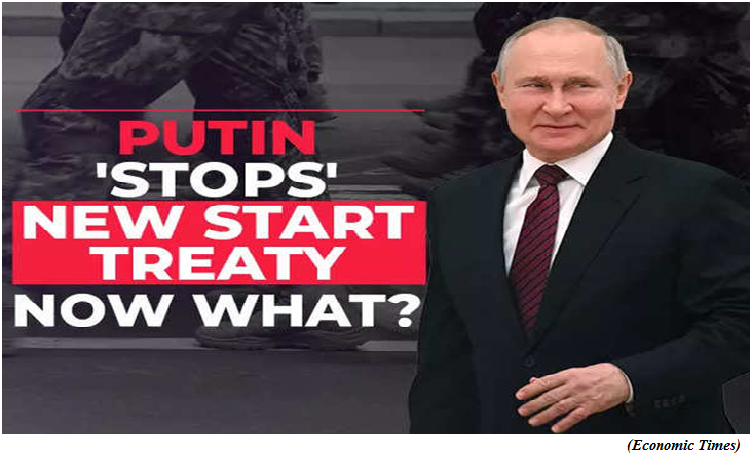The New START treaty on pause (GS Paper 2, International Relation)

Context:
- On the eve of the first anniversary of his country’s “special military operation” in Ukraine, Russian President Vladimir Putin announced unilaterally suspending the last remaining nuclear arms control treaty with the U.S., stating that the West was trying to destroy Russia.
- He said Russia ought to stand ready to resume nuclear weapons tests if the U.S. does. This move would end a global ban in place on nuclear weapons tests since Cold War times.
What is the New START nuclear treaty?
- About half a decade before the end of the Cold War, the then leaders of the U.S. and the erstwhile Soviet Union, Ronald Reagan and Mikhail Gorbachev, declared in a historic statement: “a nuclear war cannot be won and must never be fought.”
- The first formal dialogue, the Strategic Arms Limitation Talks (SALT), started between the two countries under former U.S. President Richard Nixon in 1969. The Anti-Ballistic Missile defence systems Treaty, which provided for the shooting down of incoming missiles, was signed in 1972, but the George W. Bush administration unilaterally pulled out of the pact in 2002.
- The Strategic Arms Reduction Treaty (START I),signed in 1991, expired in late 2009 and another treaty, the Strategic Offensive Reductions Treaty (SORT or Moscow Treaty), was signed in 2002. However, the New START treaty replaced the 2002 pact and was the last remaining nuclear weapons control agreement between the two powers who together hold 90% of the world’s nuclear arsenal.
- The New START treaty was signed in 2010 by former U.S. President Barack Obama and Russian President Dmitry Medvedev and came into force in February 2011. It was extended for five years when current U.S. President Joe Biden took office in 2021.
Highlights ofNew START treaty:
- Under the Treaty, America and Russia cannot deploy more than 1,550 strategic nuclear warheads and more than 700 long-range missiles and bombers. It also limits each country to 800 deployed and non-deployed launchers and delivery vehicles.
- Additionally, it allows each side to carry out up to 18 short-notice (32 hours) on-site inspections of strategic nuclear weapons sites annually to ensure that the other country had not crossed the limits of the treaty.
- Under the agreement, Russia and the U.S. exchange data twice a year on ballistic missiles under the treaty’s purview and on bombers, test sites, nuclear bases etc. The treaty also mandates the two parties to send notifications within five days if they change or update something in their stockpile, like moving missiles to a new base or deploying a new warhead to the system.
- After first coming into effect, the pact gave both countries seven years to reduce their stockpiles, including nuclear warheads that are launched using long-range missiles, submarines, and bombers. In 2018, both nations met the arms limits prescribed by the pact.
- Inspections under the treaty, however, have stalled in the past three years. They were first put on hold in March 2020 owing to the COVID-19 pandemic.
- They were due to discuss the restarting of inspections in November 2022, but this was postponed by Russia. There has been no development in this regard since.
Why did the Russian President suspend New START?
- Russian President said the North Atlantic Treaty Organisation (NATO) and the U.S. wanted to “inflict ‘strategic defeat’ on Russia and “try to get to its nuclear facilities at the same time.”
- He argued that while the U.S. had pushed for the resumption of inspections of Russian nuclear facilities under the treaty, NATO allies were helping Ukraine mount drone attacks on Russian air bases hosting nuclear-capable strategic bombers.
- In December, the Russian military had said it shot down the drones that struck two bomber bases deep inside the country.
- The Russian President also accused the U.S. of rejecting Russian requests for visits to specific U.S. facilities.
Will it trigger an arms race?
- Notably, since Russia has not withdrawn from the treaty and just ‘suspended’ it, which is a term not defined in the official pact, analysts are saying the move would not immediately trigger an arms race between the two powers, and could be a part of Russia’s political messaging amid the West’s massive assistance to Ukraine amid the year-long conflict.
- Evidently, the Russian administration also announced that it does not plan to breach the limits on warheads prescribed in New START. The Russian Foreign Ministry said that it would continue notifying US of planned test launches of inter-continental ballistic missiles (ICBMs).
- Russia’s move is linked to the Ukraine conflict, indicating that the country no longer thinks that nuclear arms control is a separate issue from the ups and downs of bilateral relations.
What does the suspension mean for global arms control?
- Following Russia’s announcement, NATO Secretary-General said the move had made the world a more dangerous place, adding that “with today’s decision on New START, full arms control architecture has been dismantled.”
- Observers say the move not only disturbs the fragile calculus of nuclear arms controls between the two largest nuclear powers but could also give an opportunity to other nuclear-armed countries, especially China and others like Pakistan, Iran, Israel, and India among others, to increase their arsenals.
- The move could hamper arms control cooperation between the U.S. and China. This is only going to make China even less interested in pursuing cooperative nuclear security with the United States.


